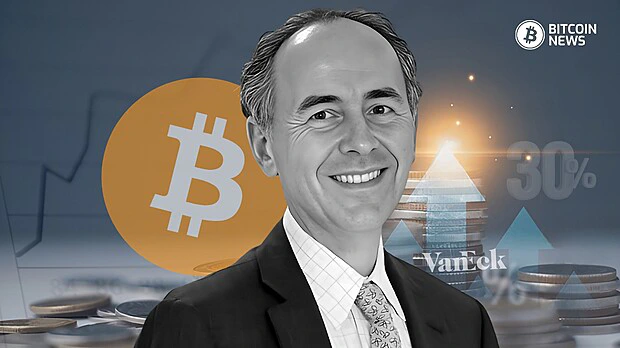In recent statements that have sent ripples through both the financial and Bitcoin worlds, Jan van Eck, CEO of investment management firm VanEck, has made headlines by declaring that Bitcoin constitutes “way over 30%” of his personal investment portfolio.
This bold move aligns with his passionate advocacy for Bitcoin, which he describes as a symbol of freedom.
Jan van Eck’s enthusiasm for Bitcoin is deeply personal and rooted in history. Speaking at the 2024 Bitcoin Conference, van Eck drew a compelling parallel between Bitcoin and gold, noting that both represent forms of financial freedom.
He explained:
“VanEck was founded in 1955, but we also started the first gold mutual fund in the United States in 1968 before the big inflationary run-up of the 70s, and it was illegal for Americans to hold gold at the time.”
He added: “My mum is German and she was a refugee, she tried to flee the community secret police, so I get why Bitcoin, I get why freedom.”
Van Eck’s comparison of Bitcoin to gold is more than just symbolic. He argues that like gold in the past, Bitcoin provides a hedge against governmental and economic constraints.
His personal investment in Bitcoin is a testament to his belief in its liberating potential. Bitcoin now makes up a significant portion of his assets, reflecting his confidence in its future.
Van Eck’s revelation about his personal bitcoin holdings came during a recent panel at the Bitcoin Conference. He disclosed that he has invested “way over 30%” of his portfolio in bitcoin, emphasizing his belief in its long-term value.
“I always wanna tell people what I’m doing personally, because they should know, I’m like, way over 30%,” van Eck told the audience. His significant stake in bitcoin is not just a personal investment but also a public endorsement of the digital asset’s potential.
This level of investment is notable, especially given the volatility that can be associated with bitcoin. Van Eck’s confidence contrasts sharply with traditional investment advice, which often advocates for portfolio diversification to mitigate risk.
Despite this, van Eck questions why investors should sell bitcoin if they are bullish on its future. He said:
“The toughest allocation question I have, and I know a lot of individuals think about this as well, is that, why should I be selling bitcoin if I believe in the super bull case?”
Van Eck’s optimism about bitcoin is underpinned by bold projections. His firm recently suggested that bitcoin could reach $2.9 million per coin by 2050 if it becomes a global reserve asset.
This prediction highlights van Eck’s belief in Bitcoin’s transformative potential.
“Everyone I meet at Bitcoin conferences owns way more in their own portfolio,” he noted, reflecting a common sentiment among Bitcoin enthusiasts who see the digital asset as undervalued compared to its future prospects.
This vision of bitcoin’s future aligns with the broader trend of increasing institutional interest in the digital currency.
VanEck, which manages approximately $100 billion in assets, has been at the forefront of this trend, offering Bitcoin investment products and advocating for broader adoption.
Related: VanEck to Launch Australia’s First Bitcoin ETF on ASX
The institutional adoption of Bitcoin has accelerated in recent years, with the launch of Bitcoin ETFs contributing to its mainstream acceptance. VanEck’s own Bitcoin Trust has amassed over $714 million in assets.
This growing institutional interest is reflected in recent market movements, with bitcoin recently climbing to $68,000, buoyed by van Eck’s public endorsement and other institutional investments.
In another noteworthy development, Jersey City recently revealed a 2% allocation of pension funds to Bitcoin ETFs, signaling a broader trend among funds and institutional investors to include bitcoin in their portfolios.
Similarly, the State of Wisconsin Board announced holdings of over $63 million in the Grayscale Bitcoin Trust Fund.
These developments underscore the increasing confidence in bitcoin as a legitimate and valuable asset. Van Eck’s investment and the growing presence of bitcoin in institutional portfolios suggest a future where Bitcoin could play a significant role in global finance.
Van Eck’s projections for bitcoin’s future are both ambitious and optimistic.
In addition to the $2.9 million price target by 2050, he believes bitcoin could account for up to 10% of global trade by 2025. These forecasts reflect a strong belief in bitcoin’s potential to become a key component of the global financial system.
However, van Eck also acknowledges the challenges and risks associated with Bitcoin. He emphasizes the importance of understanding Bitcoin’s unique characteristics and the need for a long-term perspective when investing in digital assets.
While he is bullish on bitcoin, he advises investors to approach the asset class with caution and to carefully consider its role in a diversified investment portfolio.










